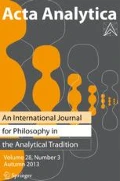Abstract
John Locke’s distinction between primary and secondary qualities of objects has meet resistance. In this paper I bypass the traditional critiques of the distinction and instead concentrate on two specific counterexamples to the distinction: Killer yellow and the puzzle of multiple dispositions. One can accommodate these puzzles, I argue, by adopting Thomas Reid’s version of the primary/secondary quality distinction, where the distinction is founded upon conceptual grounds. The primary/secondary quality distinction is epistemic rather than metaphysical. A consequence of Reid’s primary/ secondary quality distinction is that one must deny the original version of Molyneux’s question, while one must affirm an amended version of it. I show that these two answers to Molyneux’s question are not at odds with current empirical research.
Similar content being viewed by others
References
Ackroyd, C., Humphrey, N.K. and Warrington, E.K. (1974): “Lasting Effects of Early Blindness: A Case Study”.Quarterly Journal of Experimental Psychology 26, pp. 114–124.
Berkeley, G. (1710):Principles of Human Nature. Reprinted 1975 in Ayers, M.R. (eds.)Berkeley: Philosophical Writings, London, Dent.
Boyle, R. (1772): “Experiments and Observation upon Colors” and “The Origins and Forms of Qualities”. In Boyle, R.Works vol. 1, 3, London, Birch.
Cope, Z. (1953):William Cheselden. Edinburgh and London, E. and S. Livingstone.
Fine, I. et al. (2003): “Long-term Deprivation Affects Visual Perception and Cortex”.Nature Neuroscience 6, pp. 915–916.
Gregory, R.L. (1987): “Blindness, Recovery from”. In Gregory, R.L. (eds.)The Oxford Companion to the Mind, Oxford, Oxford University Press.
Gregory, R.L. (2003): “Seeing After Blindness”.Nature Neuroscience 6, pp. 909–910.
Gregory, R.L. and Wallace, J.G. (1963):Recovery from Early Blindness. Experimental Psychology Society Monograph No. 2, Cambridge, Heffer.
Hopkins, R. (2005): “Thomas Reid on Molyneux’s Question”.Pacific Philosophical Quarterly 86, pp. 340–364.
Lance, M.N. and O’Leary-Hawthorne, J. (1997):The Grammar of Meaning. Cambridge, Cambridge University Press.
Latta, R. (1904): “Notes on a Case of Successful Operation for Congenital Cataract in an Adult”.British Journal of Psychology 1, pp. 135–150.
Lehrer, K. (1978): “Reid on Primary and Secondary Qualities”.The Monist, 61, pp. 184–191.
Lewis, D. (1999):Papers in Metaphysics and Epistemology. New York, Cambridge University Press.
Locke, J. (1690):An Essay concerning Human Understanding. Reprinted 1975, Nidditch, P.H. (eds.), Oxford, Clarendon Press.
Harman, G. (1994): “Doubts about Conceptual Analysis”. In O’Leary-Hawthorne, J. and Michael, M. (eds.),Philosophy in Mind: The Place of Philosophy in the Study of Mind, Dordrecht, Kluwer Academic Press.
McKitrick, J. (2002): “Reid’s Foundation for the Primary/Secondary Quality Distinction.The Philosophical Quarterly 209, pp. 478–494.
Reid, T. (1764):An Inquiry into the Human Mind. On the Principles of Common Sense. Reprinted 1997, Brookes, D.R. (eds.) Edinburgh, Edinburgh University Press.
Reid, T. (1785):Essays on the Intellectual Powers of Man. Reprinted 1941, Woozley, A.D. (eds.) London, Macmillan and Co. Ltd.
Senden, M. von (1932):Raum- und Gestaltauffassung bei operierten Blindgeborenen. Leipzig, J.A. Barth.
Valvo, A. (1971):Sight Restoration after Long-Term Blindness: The Problems and Behaviour Patterns of Visual Rehabilitation. New York, American Foundation for the Blind.
Author information
Authors and Affiliations
Corresponding author
Rights and permissions
About this article
Cite this article
Borge, S. Some remarks on Reid on primary and secondary qualities. Acta Anal 22, 74–84 (2007). https://doi.org/10.1007/BF02866211
Received:
Revised:
Issue Date:
DOI: https://doi.org/10.1007/BF02866211


